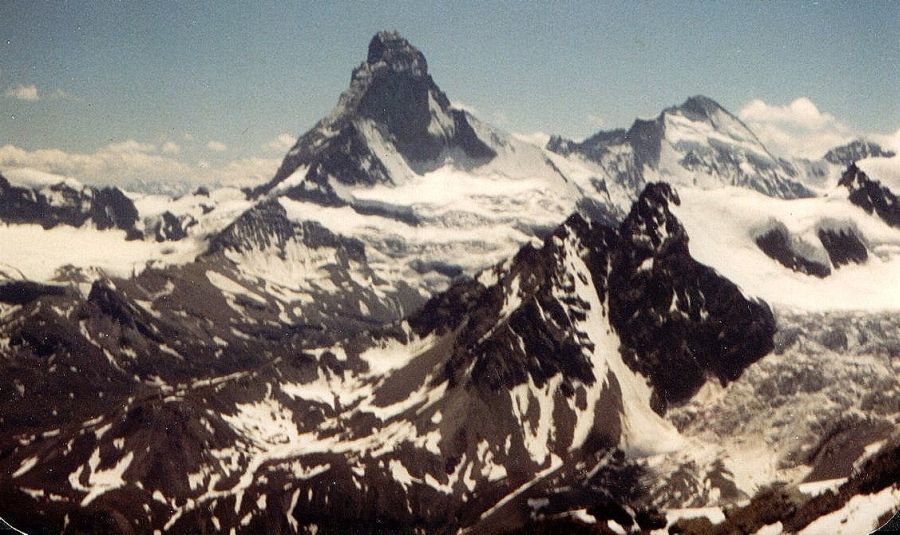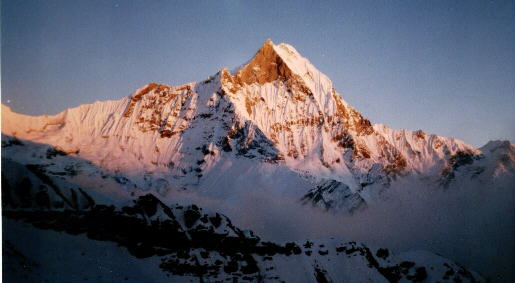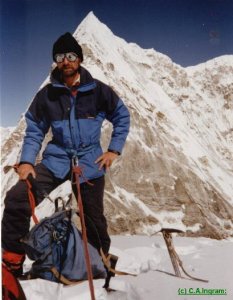 |
 |
“Because it’s there is the classic and simplistic justification for climbing a mountain, but there are usually other reasons. While aspirant Munroists must scale each and every one of the many look-a-like 277 summits ( such as the four, flat-topped Geal Charns ) scattered throughout the Scottish Highlands, connoisseurs can be more particular in deciding on which objectives to spend their available time, energy and money.
Eye-catching peaks such as the Matterhorn in the European Alps and Ama Dablam in the Nepal Himalaya are natural magnets while my friend Horst has expressed an interest in a shapely target he spotted in his travels in the Peruvian Andes.
 |
from |
The challenge and degree of difficulty of a route are also considerations. Scaling Ben Nevis by one of its three ridges ( Castle, Tower, Observatory ) is far more interesting than a trudge up the tourist path. Remoteness is a feature that attracts expeditions to unfrequented locations such as Greenland and Spitzbergen.
For those seeking to break new ground and establish new routes 6000 metre and 7000 metre mountains remain to be climbed in the vast tracts of the Himalaya, but these can present problems regarding accessability and securing permissions and permits. Some such as Macchapucchre ( the "Fish-Tail Mountain" ) are sacred and forbidden.
 |
from Rakshi Peak |
Despite protests to the contrary, altitude is a fundamental factor and most mountaineers are keen to improve their personal bests. “Have you climbed Everest?” is the inevitable question if one has been to the Himalaya. Notwithstanding his illustrious record of achievements on other 8000 metre mountains, it must have been a great sense of relief as well as satisfaction when Sir Chris Bonington eventually made his ascent of the world’s highest mountain.
Once one ventures into the bigger mountains the invisible and insiduous effects of AMS ( Acute Mountain Sickness ) must be taken into account. The two most important factors to counteract it are fitness and acclimatisation but individual physiology is critical. When Rebecca Stevens reached the summit of Everest ( the first British woman to do so ) an SAS officer in her group could not.
Previous experience at altitude is, moreover, no guarantee of success. Although I had breached the 6000 metres contour on several occasions, ( including ascents of Parchamo and Mera, two of Nepal’s so-called "trekking peaks" ) on my subsequent crossing of the 5,200 metres Larkya La on the circuit of Mount Manaslu I suffered an acute attack of the “mountaineer’s disease” - an enormous difficulty in putting one foot ahead of the other. I was engulfed by a tremendous mental and physical ennui and every step was a major effort.
 |
Tengi Kagi Tau from Parchamo |
Some professional guides and mountaineers spend part of the year in the Himalaya in the Northern Hemisphere and part in the Andes in the Southern Hemisphere in an attempt to maintain their acclimatisation.
Continued general ignorance of AMS is commonplace and every year there are fatalities in the Nepal Himalaya. One American was sure that the effects would wear off if he only pushed on - the worst possible thing to do. The essential first step is not to go any higher and then, if necessary, to descend as far and as fast as possible. Many on a once-in-a-lifetime, tight-for-time trip foolishly persevere against advice with tragic consequences.
Diamox can be taken to help with acclimatisation or to assist with recovery from AMS. It requires an expensive prescription in this country but can be obtained over-the-counter at a small fraction of this cost in Kathmandu.
Organised trekking groups from the better agencies carry bottles of oxygen for emergency treatment for those suffering from the rarefied atmosphere and some also take “Gamow bags” - pressurisable body bags ( named after the inventor ) to reproduce the conditions of a lower altitude.
 |
Everest from Kallar Pattar |
Hitherto, bottled oxygen was standard practice in forays into the “Death Zone” above 8000 metres but since the first ascent of Everest without the use of supplementary oxygen by Rheinhold Messner and Peter Habeler its continued use as a climbing aid is now considered unsporting. Alan Hinkes, the Yorkshireman aiming to be the first Briton to climb all 14 of the world’s 8000 metre peaks, has been criticised by his peers for his use of oxygen on his successful ascent of Everest.
However this is not a problem for recreational mountaineers and any which way you choose should be acceptable. Getting to the top of one’s selected summit ( and safely back down again ) even if it takes the assistance of a guide, the support of Sherpas and porters or the use of supplementary oxygen provides a sense of achievement and satisfaction.
( The Commentator, The (Glasgow) HERALD, Saturday 7th August 1999 )